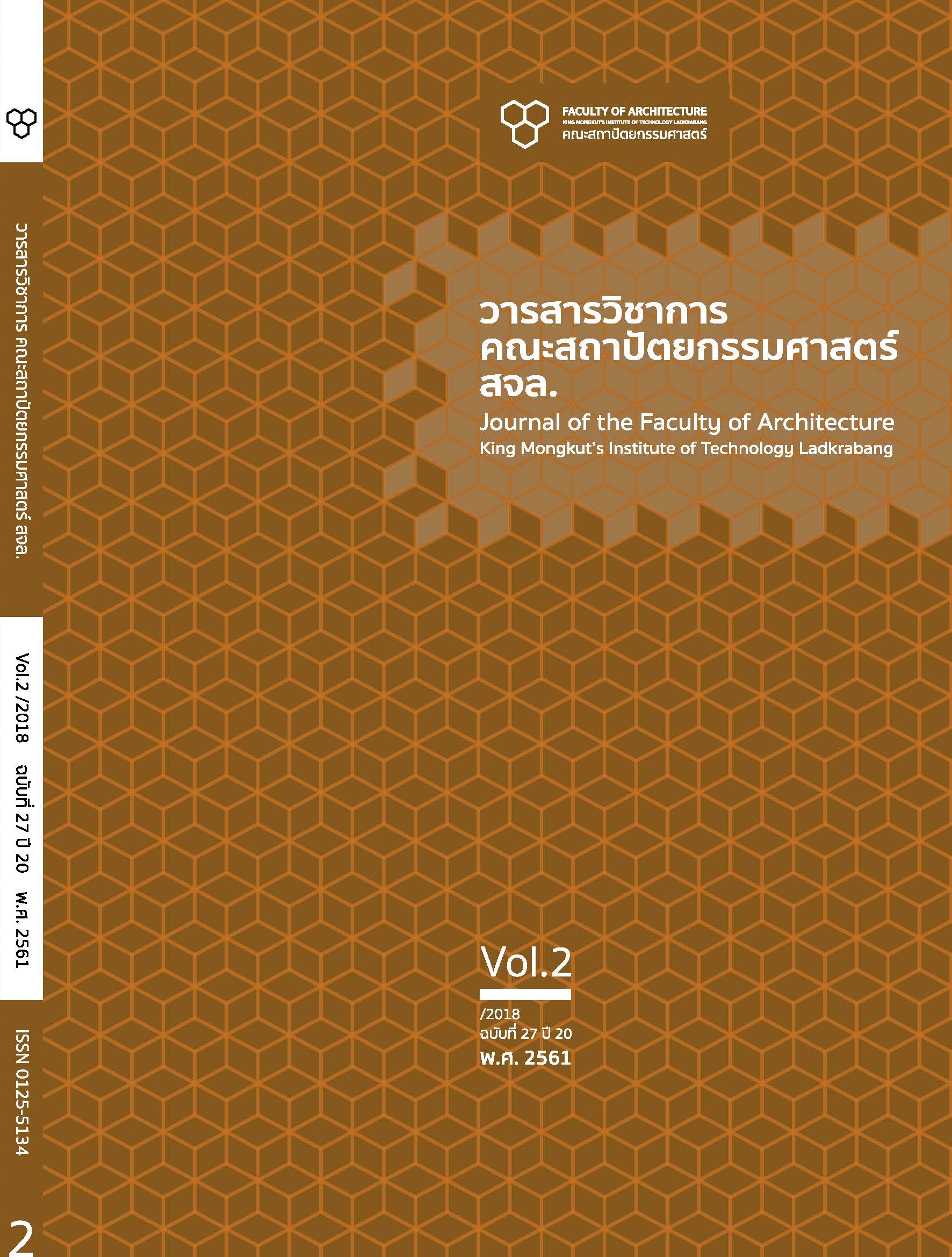แนวทางการออกแบบพื้นที่สาธารณะสำหรับชุมชนบริเวณโดยรอบมหาวิทยาลัยอัสสัมชัญ วิทยาเขตสุวรรณภูมิ A Design Guideline for Community Public Space within the Vicinity of Assumption University, Suvarnabhumi Campus
Main Article Content
Abstract
บทคัดย่อ
การทำวิจัยในหัวข้อ “แนวทางการออกแบบพื้นที่สาธารณะสำหรับชุมชนบริเวณโดยรอบ มหาวิทยาลัยอัสสัมชัญวิทยาเขตสุวรรณภูมิ” มีเป้าหมายเพื่อหาแนวทางการพัฒนาชุมชนโดยมีวัตถุประสงค์เพื่อ 1) ศึกษาทำความเข้าใจกับสภาพชุมชนปัจจุบันที่มีการเปลี่ยนแปลงของบริบท 2) ศึกษาลักษณะทางกายภาพเพื่อการออกแบบพื้นที่สาธารณะสำหรับชุมชนที่ส่งเสริมแนวคิดในการสร้างปฏิสัมพันธ์ทางสังคมให้เกิดเป็นชุมชนที่น่าอยู่ 3) ส่งเสริมการสร้างศักยภาพชุมชนให้เกิดการพัฒนาชุมชนที่ยั่งยืน 4) เสนอแนวทางการออกแบบพื้นที่สาธารณะสำหรับชุมชนเพื่อพัฒนาทางกายภาพ
การวิจัยนี้เป็นงานวิจัยเชิงประยุกต์เพื่อสร้างความเข้าใจเกี่ยวกับบริบททางด้านกายภาพและสังคมที่เปลี่ยนแปลงไปของชุมชน เก็บรวบรวมข้อมูลทุติยภูมิและข้อมูลปฐมภูมิ เครื่องมือที่ใช้ในการวิจัยประกอบด้วย แบบสอบถามการสัมภาษณ์ และการสังเกตการณ์ นำข้อมูลทั้งหมดมาวิเคราะห์เพื่อนำเสนอแนวทางการพัฒนาพื้นที่สาธารณะเพื่อส่งเสริมให้เกิดการสร้างปฏิสัมพันธ์รวมไปถึงการใช้ชีวิตที่มีคุณภาพของชุมชนบริเวณโดยรอบมหาวิทยาลัยอัสสัมชัญวิทยาเขตสุวรรณภูมิ เป็นกรณีศึกษา
ผลการวิจัยพบว่าสามารถจัดกลุ่มตัวอย่างกรณีศึกษาแนวทางการพัฒนาพื้นที่สาธารณะสาหรับชุมชนออกได้เป็น 3 แนวทางหลักนำมาประยุกต์ใช้กบั พื้นที่ที่มีความแตกต่างกัน ตามสภาพแวดล้อมลักษณะทางกายภาพดังนี้ 1) พื้นที่ศูนย์กลางของชุมชนเดิม ซึ่งประกอบด้วยหน่วยงานราชการ ตลาดและวัด เสนอแนะแนวทางการพัฒนาให้เกิดพื้นที่สาธารณะสาหรับชุมชนเพื่อตอบสนองต่อการสร้างโครงข่ายพัฒนาและส่งเสริมกิจกรรมนันทนาการที่จะเกิดขึ้น ภายในชุมชน 2) พื้นที่โล่งบริเวณริมคลองพระองค์เจ้าไชยานุชิต เสนอให้มีการพัฒนาพื้นที่สาธารณะเพื่อกิจกรรมพักผ่อนหย่อนใจและเป็นพื้นที่เรียนรู้ระบบนิเวศบริเวณริมคลอง 3) พื้นที่บริเวณกลุ่มหอพักนักศึกษา เสนอให้มีการส่งเสริมการพัฒนาพื้นที่สาธารณะเพื่อการพัฒนาและแลกเปลี่ยนการเรียนรู้ระหว่างคนในชุมชน
ในการทำวิจัยนี้ได้นำเสนอประเด็นสาคัญ และแนวความคิดในการออกแบบเพื่อพัฒนาพื้นที่สาธารณะสำหรับชุมชนให้น่าอยู่และยั่งยืน ซึ่งสามารถใช้เป็นแนวทางเพื่อนำไปพัฒนาเป็นนโยบายให้กับองค์การบรหารส่วนตำบลและมหาวิทยาลัย ซึ่งจะเป็นก้าวสำคัญที่ให้เกิดความร่วมมือและประโยชน์ร่วมกันต่อไป
คำสำคัญ : การออกแบบพื้นที่สาธารณะ พื้นที่สาธารณะชุมชน พื้นที่ปฏิสัมพันธ์ อัตลักษณ์ชุมชน
Abstract
This research entitled “A Design Guideline for Community Public Space within the Vicinity of Assumption University, Suvarnabhumi Campus” aims to explore the directions of community development with the following objectives: 1) to study and gain an understanding of the changing contexts of the community, 2) to encourage the development of public space for supporting the interaction and generating the activities among a variety of people in the community in order to make it more livable, 3) to enhance the community’s potentials for sustainable community, and 4) to propose design guidelines for the physical development of the community public space.
This research is an applied research using both primary and secondary data to understand the changing contexts of the community. The data collection tools include questionnaires, interviews, and observations. The collected data were analyzed to propose design guidelines for the development of community public space which will encourage social interaction and enable people to have a better living quality. The community within the vicinity of Assumption University, Suvarnabhumi Campus is selected for study.
According to the research findings, three concepts for the development of community public space can be applied to the study area in three different locations depending on their environmental and physical characteristics: 1) for the current community center consisting of the local government offices, markets, and a
temple, the concept is to develop recreational activity network, 2) for the open space along Phra Ong Chao Chaiyanuchit Canal, the development of a community public space is proposed for relaxation activities and education of ecological system along the canal, and 3) for the dormitories and residential areas, a community
public space will be developed for learning purpose and knowledge exchange among people in the community.
This research aims to identify key issues and propose directions for sustainable development of community public space, which can be used as design guidelines for the subdistrict administrative organization to apply or develop further in cooperation with Assumption University. This will be an important step to create mutual benefits for both the community and the involved organizations in the future.
Keywords: Public Space Design, Community Public Space, Social Interaction Space, Neighborhood Identity
Article Details
This work is licensed under a Creative Commons Attribution-NonCommercial-ShareAlike 4.0 International License.
Copyright Transfer Statement
The copyright of this article is transferred to Journal of The Faculty of Architecture King Mongkut's Institute of Technology Ladkrabang with effect if and when the article is accepted for publication. The copyright transfer covers the exclusive right to reproduce and distribute the article, including reprints, translations, photographic reproductions, electronic form (offline, online) or any other reproductions of similar nature.
The author warrants that this contribution is original and that he/she has full power to make this grant. The author signs for and accepts responsibility for releasing this material on behalf of any and all co-authors.
References
สำนักปลัดองค์การบริหารส่วนท้องถิ่น ตำบลบางบ่อ. (2560). แผนพัฒนาท้องถิ่นสี่ปี (พ.ศ. 2561-2564). สมุทรปราการ.
สำนักปลัด องค์การบริหารส่วนท้องถิ่น ตำบลบางเสาธง. (2557). แผนยุทธศาสตร์การพัฒนา (พ.ศ. 2558-2562).สมุทรปราการ.
สำนักปลัด องค์การบริหารส่วนท้องถิ่น ตำบลบางเสาธง. (2560). แผนพัฒนาท้องถิ่นสี่ปี (พ.ศ. 2561-2564).สมุทรปราการ.
Gehl, J. (1987). Life Between Building: Using Public Space. (J. Koch, Trans) New York: Van Hostrand
Reinhold.Institute for Sustainable Communities. (1997). Sustainable Community. Retrieved from: https://sustain.org/impact/definition-sustainable-community.
Jacobs, J. (1961). The Death and Life of Great American Cities. New York: Vintage Books.
Pleumarom N. ( 1988) . SoZiale,ökalogische und Ästhetische Aspekte der Freiraumplanung in Bangkok.Kassel: Gesamthochschulbibliothek.
Project for Public Spaces. (2005). What Make a Place Great. R etrieved from: https://www.pps.org/article/august2005 whatmakesplacegreat.


